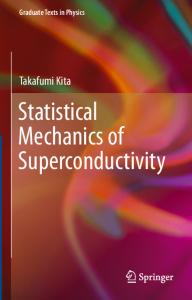Statistical Mechanics of Phase Transitions with a Hierarchy of Structures
- PDF / 256,334 Bytes
- 4 Pages / 420.48 x 639 pts Page_size
- 63 Downloads / 329 Views
STATISTICAL MECHANICS OF PHASE TRANSITIONS WITH A HIERARCHY OF STRUCTURES A. NIHAT BERKER*, ROBERT G. CAFLISCH**, AND MEHRAN KARDAR* *Department of Physics, Massachusetts Institute of Technology, Cambridge, Massachusetts 02139, USA **Exxon Production Research Company, P.O. Box 2189, Houston, Texas 77252, USA ABSTRACT Rescaling (renormalization-group) [1] and restructuring [2] transformations are used in the statistical mechanics of systems with different complexities at different length scales, starting with the microscopic scale. These transformations are effected by a partial trace of the partition function, yielding effective coupling constants that incorporate the free energy contribution of the structures and length scales that are summed out of the problem. An example of this approach is a quantitative treatment [3] of the phase diagram of krypton adsorbed onto graphite. At the smallest length scales, adatom adsorption (first and second layer) and vibrations at adsorption sites are considered. At the next scale, sublattice formation and vacancy occurrence on the hexagonal graphite surface are considered. At a larger scale, heavy and superheavy domain wall formation, wall crossings and annihilations (dislocations) [4] are considered. This problem is treated by a sequence of 5 different transformations. Starting with the microscopic potentials, phase diagrams are obtained in temperature versus pressure or coverage, featuring disordered, commensurate and incommensurate solid phases, in good agreement with experiments [5]. The mechanism for reentrant phase transitions is divulged. Such solutions can be considered approximate treatments of physical systems or, alternatively, exact solutions of "hierarchical models" [6]. This "realizability" on hierarchical lattices insures the robustness of the approximation. Hierarchically structured materials occur in natural and artificial environments, and can be successfully matched by microscopic theories that are, themselves, hierarchically structured. Many modern theories of statistical mechanics based on mappings, such as rescaling (renormalization-group) transformations [1] and restructuring transformations [2], rely on physical intuition in the construction of these mappings that connect different length scales or structures. Rescaling transformations can be prefaced (or mediated) by restructuring transformations. For the study of hierarchically structured materials, these mappings can be modified appropriately as differently structured scales are accessed. Thus, the theory is taylorable to the materials. An example of such a theory has been in the study [3] of the ordering behaviors of krypton adsorbed onto graphite, from the submonolayer to the overfilled layer regimes. Different structures and fluctuations occur at different length scales and have to be treated with different approximations. A sequence of 5 different mappings were used in this work, elucidating, for the first time, puzzling experimental behavior. Specifically, the system exhibits multiple phase trans
Data Loading...











